英美文学赏析第一讲
- 格式:ppt
- 大小:136.50 KB
- 文档页数:25
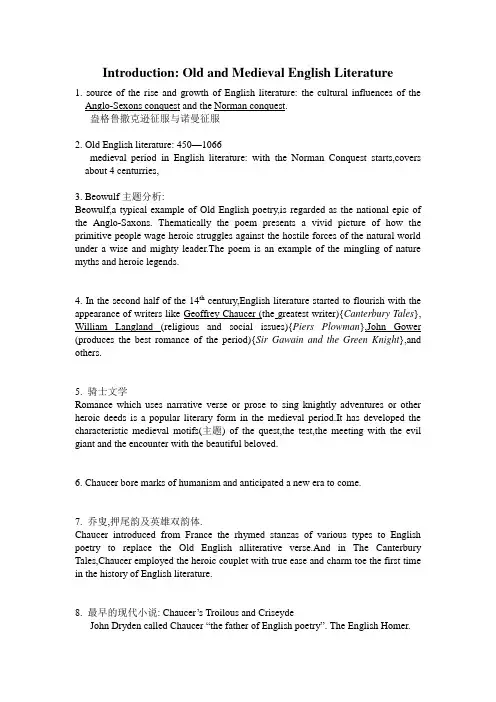
Introduction: Old and Medieval English Literature1. source of the rise and growth of English literature: the cultural influences of the Anglo-Sexons conquest and the Norman conquest.盎格鲁撒克逊征服与诺曼征服2. Old English literature: 450—1066medieval period in English literature: with the Norman Conquest starts,covers about 4 centurries,3. Beowulf主题分析:Beowulf,a typical example of Old English poetry,is regarded as the national epic of the Anglo-Saxons. Thematically the poem presents a vivid picture of how the primitive people wage heroic struggles against the hostile forces of the natural world under a wise and mighty leader.The poem is an example of the mingling of nature myths and heroic legends.4. In the second half of the 14th century,English literature started to flourish with the appearance of writers like Geoffrey Chaucer (the greatest writer){Canterbury Tales}, William Langland (religious and social issues){Piers Plowman},John Gower (produces the best romance of the period){Sir Gawain and the Green Knight},and others.5. 骑士文学Romance which uses narrative verse or prose to sing knightly adventures or other heroic deeds is a popular literary form in the medieval period.It has developed the characteristic medieval motifs(主题) of the quest,the test,the meeting with the evil giant and the encounter with the beautiful beloved.6. Chaucer bore marks of humanism and anticipated a new era to come.7. 乔叟,押尾韵及英雄双韵体.Chaucer introduced from France the rhymed stanzas of various types to English poetry to replace the Old English alliterative verse.And in The Canterbury Tales,Chaucer employed the heroic couplet with true ease and charm toe the first time in the history of English literature.8. 最早的现代小说: Chaucer’s Troilous and CriseydeJohn Dryden called Chaucer “the father of English poetry”. The English Homer.Chapter 1 The Renaissance Period1.RenaissanceIt refers to the period between the 14th and mid-17th .It first started in Italy,with the flowering of painting,sculpture,and literature.The Renaissance,shich means rebirth or revival,is actually a movement stimulated by a series of historical events.Therefore,in essence,it is a historical period in which the European hunanist thinkers and scholars made attempts to get rid of those old feudalist ideas in medieval Europe,to introduce new ideas that expressed the interests of the rising bourgeoisie.It was not until the reign of Henry VIII that the Renaissance really began to show its effect in England.2.HumanismRenaissance humanists found in the classics a justification to exalt human nature and came to see that human beings were glorious creatures capable of individual development in the direction of perfection,and that the world they inhabited was theirs not to despise but to question,explore,and enjoy.Thus,by emphasizing the dignity of human beings and the importance of the present life,they voiced their beliefs that man did not only have the right to enjoy the beautiful of this life,but had the ability to perfect himself and to perform wonders.3.人文主义者代表(best English humanists): Thomas More, Chistopher Marloweand William Shakespeare.4.By the middle of Elizabeth’s reign,Protestantism had been firmly established,witha certain compromise between Catholicism and Protestantism.5.引进印刷术的英国第一人: William Caxton.印刷了The Canterbury Tales(Chaucer), Morte Darthur(Malory)6.Petrarch was regarded as the fountainhead of literature by the English writers..7. Wyatt and Surrey engraved the forms and graces of Italian poetry. (Petrachan sonnet, blank verse)8.John Donne and George Herbert.(玄学派诗人)9. The Elizabethan drama is the real mainstream of the English Renaissance.10.Lively,vivid native English material was put into the regular form of the Latincomedies of Plautus and Terence.Tragedies were in the style of Seneca.11. The most famous dramatists in the Renaissance in England: Chistopher Marlowe,William Shakespeare,and Ben Jonson.12.Francis Bacon,the first important English essayist,was also the founder of modernscience inEngland.A.2 Shakespeare’s drama career:a.The first period,one of apprenticeship.5 histoty plays: Henry VI, Parts I, II, and III, Richard III, and Titus Andronicus.4 comedies: The Comedy of Errors, The Two Gentlemen of Verona, The Tamingof the Shrew, and Love’s Labour’s Lost.b.The second period,Shakespear’s style and approach became highlyindividualized.5 histories: Richard II, King John,Henry IV, Parts I, II, and Henry V.6 comedies: A Midsummer Night’s Dream, The Merchant of Venice, Much AdoAbout Nothing, As You Like It, Twelfth Night, and The Merry Wives of Windsor.2 tragedies: Romeo and Juliet, and Julius Caesar.c.The third period includes his greatest tragedies and his so-called dark comedies.Tragedies: Hamlet(most popular), Othello, King Lear, Macbeth, Antony and Cleopatra, Troilus and Cressida, Coriolanus.2 comedies: All’s Well That Ends Well and Measure for Measure.d.The last period of Shakespeare’s(there’s a prevalent Christian teaching ofatonement [赎罪] ) work includes his principal romantic tragicomedies: Pericles, Cymbeline, The Winter’s Tale and The Tempest.2 final place: Henry VIII and The Two Noble Kinsmen.A.3 历史剧:Shakespeare’s history plays are mainly written under the priciple that national unity under a mighty and just sovereign is a necessity. The first and second parts of Henry IV are undoubtedly the most widely read among his history plays.A.4 The successful romantic tragedy is Romeo and Juliet, which eulogizes(赞美)the faithfulness of love and the spirit of pursuing happiness.A.5 四大悲剧的共性:(Greatest tragedies have some characteristic in common) Each portrays some noble hero,who faces the injustice of human life and is caught in a dufficult situation and whose fate is closely connected with the fate of the whole nation. Each hero has his weakness of nature. Along with the portrayal of the weakness or bias of the hero,we see the sharp conflicts between the individual and the evil force in the society, which shows that Shakespeare is a great realist in the true sense.A.6 The Tempest is a typical example of his pessimistic view towards human life and society in his late years.He affirms the importance of the feudal system in order to uphold social order. A.7 莎士比亚的学观Shakespeare has accepted the Renaissance views on literature.He holds that literature should be a combination of beauty, kindness and truth, and should reflect nature and reality. The end of the dramatic creation is to give faithful reflection of the social realities of the time. Shakespeare also states that literary words which have truly reflected nature and reality can reach immortality.A.8 莎士比亚的物刻画Shakespeare’s major characters are neither merely individual ones nor type ones; they are individuals representing certain types.Each character has his or her own personailities; meanwhile, they may share features with others.Shakespeare also protrays his characters in pairs.Contrasts are frequently used to bring vividness to his characters.A.9 莎士比亚的节设计Shakespeare’s plays are well-known for their adroit (巧妙的)plot constraction.He seldom invents his own plots.In order to play more lively and compact, he would shorten the time and intensify the story.A.10 莎士比亚的语言特色Shakespeare can write skillfully in different poetic forms.He has an amazing wealth of vocabulary and idiom.His coinage of new words and disortion of the meaning of the old ones also create stricking effects on the reader.B.1 米尔顿的三类文学成就Three groups:the early poetic works, the middle prose pamphlets and the last great poems.B.2 Lycidas(early period)Lycidas is composed for a collection of elegies dedicated to Edward King.It begins with grief and a feeling of immaturity; then the grief is deepen by the sense of irrecoverable loss in the silencing of a young poet.With this bitter sense of loss,Milton asks why the just and good should suffer.The climax of the poem is the blistering attack on the clergy,who are corrupted by self-interest.B.3 Areopagitica(middle period)is a great plea for freedom of the press.B.4 three major poetical works:Paradise lost, Pparodise regained and Samson AgonistesB.5 Paradise regained shows how mankind, in the person of Christ, withstands thetemper and is established once more in the divine favor. Crist’s temptation in the wilderness in the theme, and Milton follows the account in the fourth chapter of Matthew’s gospel(福音).B.6 米尔顿的艺术特色a. Milton’s style is distinguished by its rich and complex texture, the multiplicityof its classical references, its wealth of ornament and decoration.b. Milton’s subjects are lofty and magnificent. The theme of Samson Agonistes istragic and sublime.c. The great epic, which resounds with the grandear and multiplicity of the world,is also a poem, the central actions of which take place inwardly.d. Finally, his endinds are lifelike.13.玄学派诗人MetaphysicalIt refers to the school of poets that appeared in the Revolutionary period in England by using quite unconventional and often surprising conceits; the metaphysical poets wrote poems full of wit and humor. John Donne and Andrew Marvell are the representative metaphysical poets.14. 十四行诗SonnetIt is a basic lyric form, consisting of 14 lines of iambic pentameter rhymed in various patterns. Milton made a new kind of use of the Petrarchan form, and the Romantic poets continued in the Miltonic tratition.。
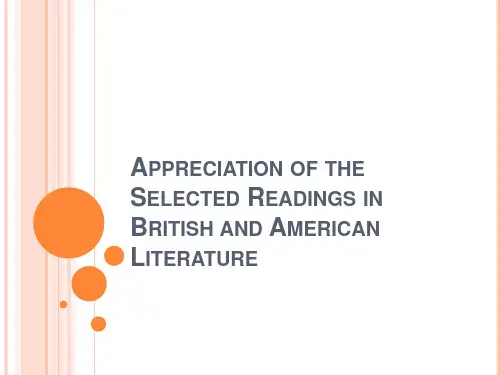
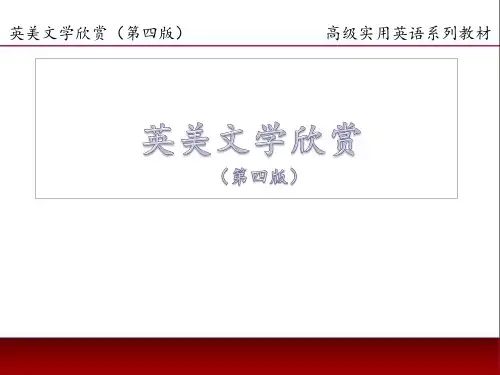
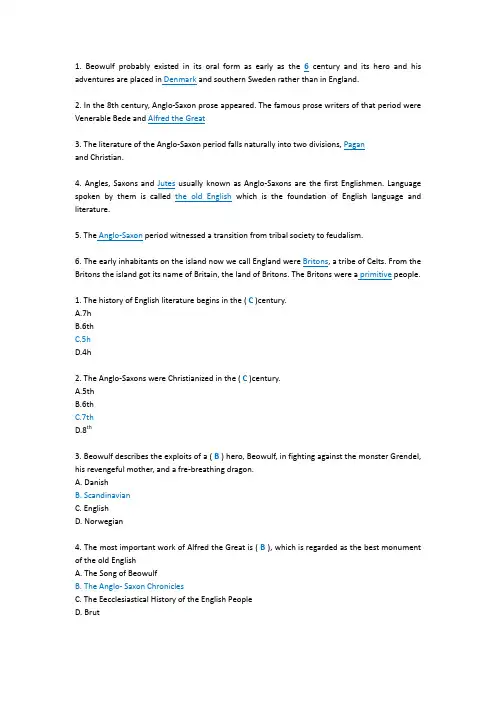
1. Beowulf probably existed in its oral form as early as the6 century and its hero and his adventures are placed in Denmark and southern Sweden rather than in England.2. In the 8th century, Anglo-Saxon prose appeared. The famous prose writers of that period were Venerable Bede and Alfred the Great3. The literature of the Anglo-Saxon period falls naturally into two divisions, Paganand Christian.4. Angles, Saxons and Jutes usually known as Anglo-Saxons are the first Englishmen. Language spoken by them is called the old English which is the foundation of English language and literature.5. The Anglo-Saxon period witnessed a transition from tribal society to feudalism.6. The early inhabitants on the island now we call England were Britons, a tribe of Celts. From the Britons the island got its name of Britain, the land of Britons. The Britons were a primitive people.1. The history of English literature begins in the ( C )century.A.7hB.6thC.5hD.4h2. The Anglo-Saxons were Christianized in the ( C )century.A.5thB.6thC.7thD.8th3. Beowulf describes the exploits of a ( B ) hero, Beowulf, in fighting against the monster Grendel, his revengeful mother, and a fre-breathing dragon.A. DanishB. ScandinavianC. EnglishD. Norwegian4. The most important work of Alfred the Great is ( B ), which is regarded as the best monument of the old EnglishA. The Song of BeowulfB. The Anglo- Saxon ChroniclesC. The Eecclesiastical History of the English PeopleD. Brut1.Old English period (the Anglo- Saxon period)Key:①The Old English Period, extended from the invasion of Celtic England by Germanic tribes (the Angles, Saxons, and Jutes) in the first half of the fifth century to the conquest of England in 1066 by the Norman French under the leadership of William the Conqueror.②Only after they had been converted to Christianity in the seventh century did the Anglo Saxons, whose earlier literature had been oral, begin to develop a written literature.2.AlliterationKey: Alliteration:①(also known as ‘head rhyme’ or ‘initial rhyme’ ), the repetition of the same sounds--usually initial consonants of words or of stressed syllables--in any sequence of neighboring words.②Now an optional and incidental decorative effect in verse or prose, it was once a required element in the poetry of Germanic languages (including Old English and Old Norse) and in Celtic verse.③Such poetry, in which alliteration rather than rhyme is the chief principle of repetition, is known as alliteration verse; its rules also allow a vowel sound to alliterate with any other vowel.3.epicKey: epic: It is, originally, an oral narrative poem, majestic both in theme and style. Epics deal with legendary or historical events of national or universal significance, involving actions of broad sweep and grandeur. Most epics deal with the exploits of a single individual, thereby giving unity to the composition. Great epics include The Iliad and The Odyssey by Homer.简答题1. What are the main characteristics of Anglo-Saxon literature?Key: Anglo-Saxon literature is almost exclusively a verse literature in oral form. It was passed down by word of mouth from generation to generation. Most of its creators are unknown. There are two groups of English poetry in Anglo-Saxon period. The first group is the pagan poetry represented by Beowulf, the second is the religious poetry represented by the works of Caedmon and Cynewulf.2.What are the artistic features of Old English poetry?Key:(1) The use of alliteration. Each full line has four stresses with a number of unstressed syllables, three of which begin with the same sound or letter.(2) The use of the strong stress and the predominance of consonants. Almost all this poetry is composed without rhyme. Each line is divided into two halves and each half has two heavy stresses.(3) The use of vivid poetic diction and parallel expressions for a single idea, such as the sea is called ‘swan road’ or ‘whale-path’, a soldier is called ‘shield-bearer’, ‘battle-hero’or ‘spear fighter’, etc.3.What are the three parts told in the story of Beowulf? How is heroic ideal reflected in Beowulf?Key:①Struc turally speaking, Beowulf is built around three fights. The first part deals with the fight between Beowulf and the monster Grendel that has been attacking the great hall of Heorot, built by Hrothgar, the Danish King. The second part involves a battle between Beowulf and Grendel's mother, a water-monster, who takes revenge by carrying off one of the king's noblemen. The last part is about the fight between Beowulf and a firedrake that ravages Beowulf's kingdom.②Beowulf is a pagan poem concerned with the he roic ideal of kings and kingship in North Europe. Battle is a way of life at that time. Strength and courage are basic virtues for both kings and his warriors. The king should protect his people and show gentleness and generosity to his warriors. And in return, his warriors should show absolute obedience and loyalty to the king. By praising Beowulf s wisdom, strength and courage, and by glorifying his death for his people, the poem presents the heroic ideal of a king and his good relations to his warriors and people.。

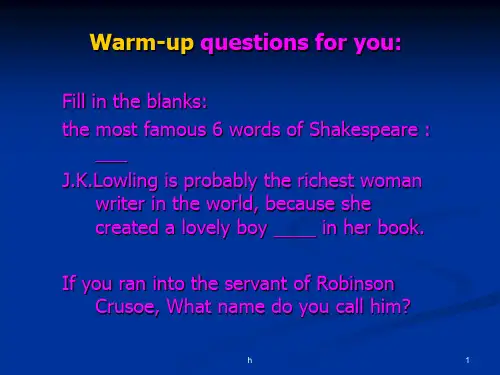

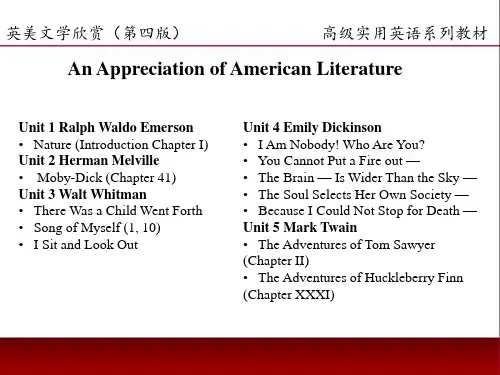
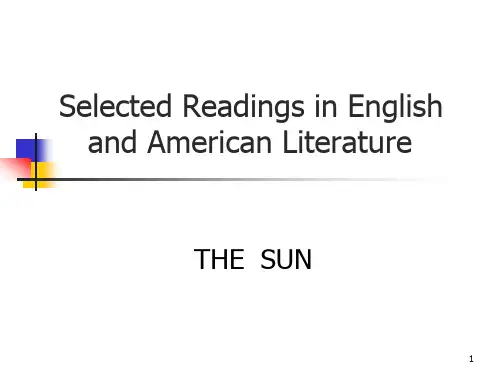
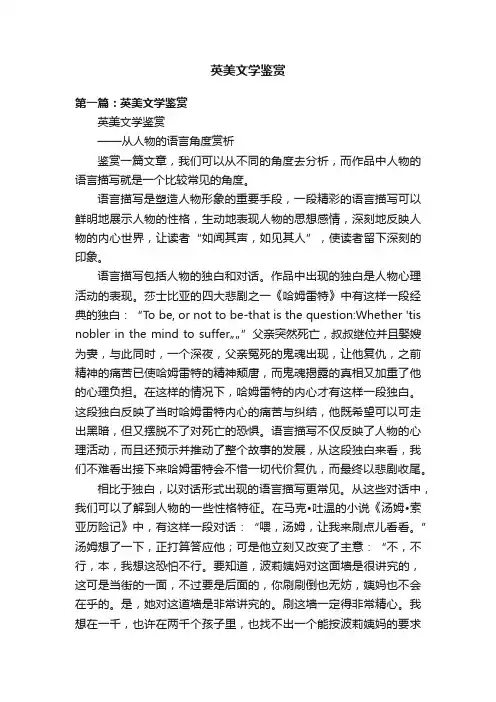
英美文学鉴赏第一篇:英美文学鉴赏英美文学鉴赏——从人物的语言角度赏析鉴赏一篇文章,我们可以从不同的角度去分析,而作品中人物的语言描写就是一个比较常见的角度。
语言描写是塑造人物形象的重要手段,一段精彩的语言描写可以鲜明地展示人物的性格,生动地表现人物的思想感情,深刻地反映人物的内心世界,让读者“如闻其声,如见其人”,使读者留下深刻的印象。
语言描写包括人物的独白和对话。
作品中出现的独白是人物心理活动的表现。
莎士比亚的四大悲剧之一《哈姆雷特》中有这样一段经典的独白:“T o be, or not to be-that is the question:Whether 'tis nobler in the mind to suffer……”父亲突然死亡,叔叔继位并且娶嫂为妻,与此同时,一个深夜,父亲冤死的鬼魂出现,让他复仇,之前精神的痛苦已使哈姆雷特的精神颓唐,而鬼魂揭露的真相又加重了他的心理负担。
在这样的情况下,哈姆雷特的内心才有这样一段独白。
这段独白反映了当时哈姆雷特内心的痛苦与纠结,他既希望可以可走出黑暗,但又摆脱不了对死亡的恐惧。
语言描写不仅反映了人物的心理活动,而且还预示并推动了整个故事的发展,从这段独白来看,我们不难看出接下来哈姆雷特会不惜一切代价复仇,而最终以悲剧收尾。
相比于独白,以对话形式出现的语言描写更常见。
从这些对话中,我们可以了解到人物的一些性格特征。
在马克•吐温的小说《汤姆•索亚历险记》中,有这样一段对话:“喂,汤姆,让我来刷点儿看看。
”汤姆想了一下,正打算答应他;可是他立刻又改变了主意:“不,不行,本,我想这恐怕不行。
要知道,波莉姨妈对这面墙是很讲究的,这可是当街的一面,不过要是后面的,你刷刷倒也无妨,姨妈也不会在乎的。
是,她对这道墙是非常讲究的。
刷这墙一定得非常精心。
我想在一千,也许在两千个孩子里,也找不出一个能按波莉姨妈的要求刷好这道墙的。
”“是吗?哎,就让我试一试吧。
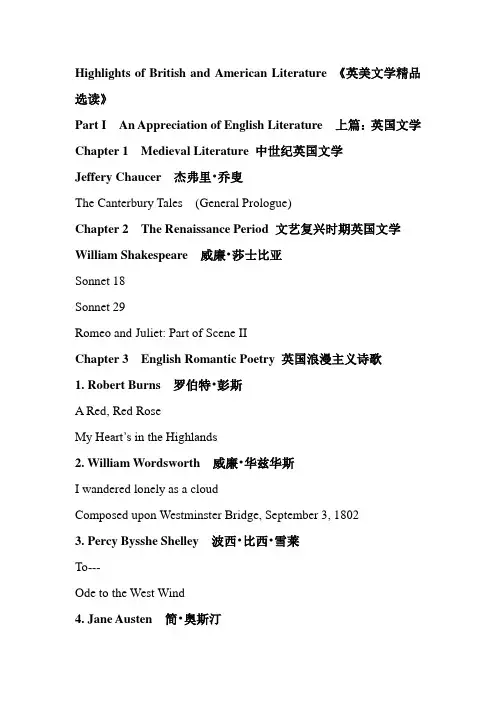
Highlights of British and American Literature 《英美文学精品选读》Part I An Appreciation of English Literature 上篇:英国文学Chapter 1 Medieval Literature 中世纪英国文学Jeffery Chaucer 杰弗里•乔叟The Canterbury Tales (General Prologue)Chapter 2 The Renaissance Period 文艺复兴时期英国文学William Shakespeare 威廉•莎士比亚Sonnet 18Sonnet 29Romeo and Juliet: Part of Scene IIChapter 3 English Romantic Poetry 英国浪漫主义诗歌1. Robert Burns 罗伯特•彭斯A Red, Red RoseMy Heart’s in the Highlands2. William Wordsworth 威廉•华兹华斯I wandered lonely as a cloudComposed upon Westminster Bridge, September 3, 18023. Percy Bysshe Shelley 波西•比西•雪莱To---Ode to the West Wind4. Jane Austen 简•奥斯汀Pride and Prejudice (Chapter I)Chapter 4 The Victorian Age 维多利亚文学时期1. Charles Dickens 查尔斯•狄更斯A Tale of Two Cities ( Chapter I)2. Bronte Sisters 布朗特姐妹Charlotte Bronte 夏洛特•布朗特Jane Eyre (Chapter XXXVIII)Emily Bronte 艾米莉•布朗特Wuthering Heights (Chapter XV)3. Robert Browning 罗伯特•布朗宁My Last Duchess FerraraMeeting At NightParting at Morning4. Elizabeth Barrett Browning 伊丽莎白•巴雷特•布朗宁Sonnets from the Portuguese: 14Sonnets from the Portuguese: 43Chapter 5 Twentieth Century Literature 二十世纪文学时期1. Thomas Hardy 托马斯•哈代Tess of the D’Urberbilles (Chapter XXXV)2. Virginia woolf 维吉尼亚•沃尔夫Mrs. Dalloway (The beginning part)Part II An Appreciation of American Literature 下篇:美国文学Chapter 1: The Romantic Period 浪漫主义时期文学1. Washington Irving 华盛顿•欧文Rip Van Winkle (The beginning part)2. Ralph Waldo Emerson 拉尔夫•瓦尔多•爱默生Nature (Chapter I)3. Edgar Allan Poe 埃德加•艾伦•坡The Raven4. Nathaniel Hawthorne (1804-1864) 纳撒尼尔•霍桑The Scarlet Letter (Chapter I, II)Chapter 2: The Literature of Realism 现实主义文学时期1.Walt Whitman 惠特曼Leaves of Grass: O Captain! My Captain!Leaves of Grass: I Hear America singing2. Emily Dickinson 艾米丽•狄金森HopeI’m NobodyI heard a Fly buzz—when I died—3. Mark Twain 马克•吐温The Adventures of Tom Sawyer (Chapter I)Chapter 3: Twentieth-century Literature 二十世纪文学时期1. Ezra Pound 埃兹拉•庞德In a Station of the MetroThe River-Merchant’s Wife: A Let ter2. Robert Frost 罗伯特•弗洛斯特The Road Not TakenStopping by Woods on a Snowy Evening3. Thomas Stearns Eliot 托马斯•斯特尔纳斯•艾略特The Waste Land (Subtitles: The Burial of the Dead)4. Francis Scott Fitzgerald 弗朗西斯•司各特•菲兹杰拉德The Great Gatsby (Chapter III)5. Ernest Hemingway 厄尼斯特•海明威The Old Man and the Sea (Chapter XXVII, XXVIII, XXXVIIII)6. William Faulkner 威廉•福克纳A Rose for Emily (Chapter I, II, III, IV)《英美文学精华选读》将简要介绍英美各时期的主要文学文化思潮,文学流派和代表作家。
第一讲-英美诗歌音步英美诗歌音步是指英语和美式英语诗歌的特殊韵律和节奏,决定了其朗诵和表现的方式。
音步包括押韵、韵脚、音节的重读和轻读,以及句子的断句和重音等。
在英美文学中,诗歌音步是一种常见的修辞手法,可以使诗歌更富有节奏感和音乐性,让读者更容易记忆、理解和感受诗歌的意境和情感。
押韵是指诗歌中某些字母或音节的末尾相同,形成的音乐效果。
英美诗歌中的押韵分为纯押韵和近音押韵两种。
纯押韵是指从最后一个重读音节开始,后面的音节在韵尾部分完全相同,如"stand"和"land"的"and"部分。
近音押韵是指韵母和辅音不完全相同,但是音节的音调和音色相似,如"love"和"move"的"ove"部分。
押韵可以加强诗歌的语言美感,增强诗歌的表现力,但是如果押韵过于平凡或不自然,会降低诗歌的质量和可读性。
韵脚是指诗歌中每行的末尾音节的规律排布,是诗歌音步的重要组成部分。
在英美诗歌中,韵脚通常是按照一定的模式排列的,如押韵模式为AABB、ABAB、ABBA等。
韵脚的变化可以改变诗歌的节奏和韵律,让诗歌更加灵动和生动。
同时,韵脚的运用也可以帮助读者更好地理解和记忆诗歌中的信息和情感。
句子的断句和重音也是英美诗歌音步的重要组成部分。
在朗读英美诗歌时,需要准确把握句子的语气和节奏,强化句子中的关键词和情感,让整个诗歌节奏流畅、韵律明显。
总之,英美诗歌音步是诗歌表现艺术的重要方面。
通过学习和掌握音步,可以更好地理解和欣赏英美诗歌的意境和情感,同时也可以提高自己的朗诵和演讲能力。